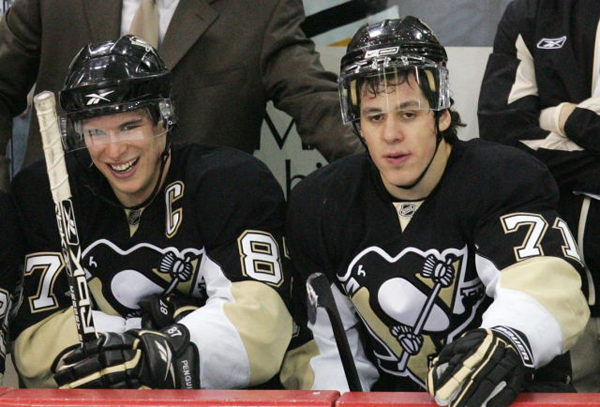Last week I came across a recent research article that I think is a real breakthrough in the hockey training world. Before I get to that, I want to quickly touch on the importance (or lack thereof) of testing.
First, let’s distinguish between assessing (screening for ROM, structural, or movement impairments), and testing (assessing performance). I think assessing has a place in many training settings, especially with older athletes who have accumulated more soft-tissue trauma and have more firmly rooted, but still reversible movement impairments. I think assessing a 12-year old with no training background is unnecessary and that time could probably be better spent teaching the kid how to move well. Groove and improve!
With regards to testing, I think using performance on tests as a comparative tool amongst players is a ridiculous notion. I’ve always said that if Sidney Crosby had a 15″ vertical jump (which is brutal for a player at that level), he’d still be one of the best players in the NHL. The off-ice performance testing shouldn’t determine the selection of players.

Think these guys have the best bench press on their team?
Simply, players should be evaluated on their on-ice ability. That said, using testing as a way for tracking and documenting a player’s off-ice development isn’t a bad idea. In fact, in the case of more elite players (more specifically, those with an “older” training age), it will help document the effectiveness of the program. In the case of players with a younger training (because any form of training will work for these players), showing objective progress will help them buy in to the importance of training, which is also worthwhile.
The big caveat with testing is that there has never been any real evidence that higher levels of off-ice athleticism lead to improved on-ice performance. In other words, we know that someone fast off the ice is likely to be fast on the ice (if they learn to skate well), but will that mean that they score more goals, have more assists, have a better +/- or are better than their peers at any other game-specific marker of performance? Intuitively I think we can all appreciate the importance of making improvements in athleticism (speed, strength, power, etc.). In fact, I make a living training hockey players to do just that. IMPROVEMENTS will lead to improved performance, but ABSOLUTES have never been linked to better performance.
“You can’t score goals in the weight room.”
That’s a running joke with me and a few of the players at Endeavor Sports Performance. While there is some truth to that, a new research article demonstrates, for the first time, that there is a connection between off-ice and on-ice performance.
Peyer et al. (2011) measured the Michigan State University Men’s Hockey Team’s (NCAA D1):
Plus/Minus was used as the primary indicator of hockey performance because of it’s ability to effectively incorporate both offensive and defensive efforts. An argument can be made that a similar analysis should be performed with other performance measures, but we’ll leave that for future research. All things considered, plus/minus is the best single choice available.
Quick Editors Note: This study was conducted on MSU’s hockey team the year they won the National Championship. This may or may not mean anything to you, but I think it’s important to point out that this wasn’t performed on a team that got walked on through the year. This was an incredible group of players.
The Results
Notable findings included:
Interpreting the Findings
It’s not surprising to see that forwards had higher VO2Max values than defensemen. This is likely a combination of both an adaptation to the position and a natural selection precluding the athletes to start. In other words, players that have difficulty keeping up with the pace of forward play may be moved back to play defense at young ages and just stay there. This is NOT evidence that forwards need to do more aerobic training. Quite the contrary. The evidence is clear in that anaerobic interval training increases V02Max equally as well as aerobic training, and with hockey players interval training is much more sport-relevant. This is also reflected in the correlation between repeat sprint performance and plus/minus. Hockey players need to be fast, consistently.
While I don’t necessarily agree with all of the tests chosen, the authors explained that the tests were included as part of the team’s yearly testing and many are included in NHL testing procedures. This doesn’t make it right, but it allows me to understand why they chose the tests they did. That said, it was interesting to see that strength (lower body and upper body) and repeat-sprint ability were the two qualities most predictive of plus-minus. This should come as no surprise to most of you, but it certainly has some important implications. The authors summed up a major conclusion brilliantly:
“Aerobic fitness and body composition do not appear to be significant predictors of player performance as measured by the +/- system or coach evaluation. To maximize the efficiency of preseason testing, coaches may rely on strength (chin-ups, leg press, and bench press) and repeat sprint tests while decreasing the number of aerobic capacity and body composition analyses to minimize player burden…”
Hopefully this will provide further evidence for some of the coaches that have hesitated to take out their continuous run and VO2 tests that there are better ways of assessing a player’s conditioning.
One of the other interesting findings is that the coaches of this team independently ranked the players in order of ability. The authors took the top 6 (5F, 1D) and bottom 6 (3F, 3D) and found that the only variable that differed significantly between them was plus/minus. That is not surprising. You’d assume your best players have a better plus/minus than your worst. However, the authors noted that the top 6 players exhibited a trend toward being younger, heavier, faster in the repeat-sprint test, and stronger in their lower body. While you can’t draw massive conclusions from trends taken from a breakdown of a single team, I think this alludes to the importance of developing lower body mass and strength. This seems like a relatively intuitive concept, but the reality is that most high school players default to the “my legs are big enough” excuse for not lifting legs and focus primarily on their mirror muscles.
The big take home from this is that a hockey player’s training program CANNOT neglect strength work, and that interval-based work is more appropriate for conditioning purposes. It appears that strength and repeat-speed (e.g. hockey conditioning) are most predictive of on-ice success. That…and a clean sheet of ice:

To your success,
Kevin Neeld
Reference:
Peyer, K., Pivarnik, J., Eisenmann, J., & Vorkapich, M. (2011). Physiological Characteristics of National Collegiate Athletic Association Division I Ice Hockey Players and Their Relation to Game Performance. Journal of Strength and Conditioning Research, 25(5), 1183-1192.